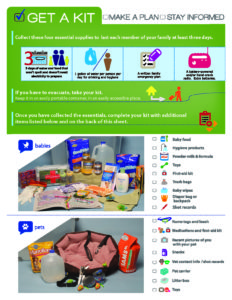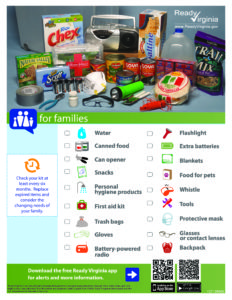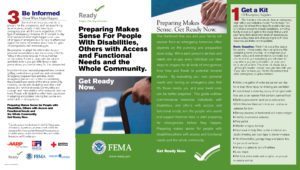Build a Kit
Basic Emergency Supply Kit

A basic emergency supply kit could include the following recommended items:
- Water, one gallon of water per person per day for at least three days, for drinking and sanitation
- Food, at least a three-day supply of non-perishable food
- Battery-powered or hand crank radio and a NOAA Weather Radio with tone alert and extra batteries for both
- Flashlight and extra batteries
- First aid kit
- Whistle to signal for help
- Dust mask to help filter contaminated air and plastic sheeting and duct tape to shelter-in-place
- Moist towelettes, garbage bags and plastic ties for personal sanitation
- Wrench or pliers to turn off utilities
- Manual can opener for food
- Local maps
- Cell phone with chargers, inverter or solar charger
Additional Emergency Supplies

Download Printable Version
Once you have gathered the supplies for a basic emergency kit, you may want to consider adding the following items:
- Prescription medications and glasses
- Infant formula and diapers
- Pet food and extra water for your pet
- Cash or traveler’s checks and change
- Important family documents such as copies of insurance policies, identification and bank account records in a waterproof, portable container. You can use the Emergency Financial First Aid Kit – EFFAK (PDF – 977Kb) developed by Operation Hope, FEMA and Citizen Corps to help you organize your information.
- Emergency reference material such as a first aid book or free information from this web site.
- Sleeping bag or warm blanket for each person. Consider additional bedding for cold-weather emergencies.
- Complete change of clothing including a long sleeved shirt, long pants and sturdy shoes. Consider additional clothing for cold-weather emergencies.
- Household chlorine bleach and medicine dropper – When diluted, nine parts water to one part bleach, bleach can be used as a disinfectant. Or in an emergency, you can use it to treat water by using 16 drops of regular household liquid bleach per gallon of water. Do not use scented, color safe or bleaches with added cleaners.
- Fire extinguisher
- Matches in a waterproof container
- Feminine supplies and personal hygiene items
- Mess kits, paper cups, plates, paper towels and plastic utensils
- Paper and pencil
- Books, games, puzzles or other activities for children
Preparing a First Aid Kit

In any emergency a family member or you yourself may suffer an injury. If you have these basic first aid supplies you are better prepared to help your loved ones when they are hurt.
Knowing how to treat minor injuries can make a difference in an emergency. You may consider taking a first aid class, but simply having the following things can help you stop bleeding, prevent infection and assist in decontamination.
- Two pairs of latex or other sterile gloves if you are allergic to latex
- Sterile dressings to stop bleeding
- Cleansing agent/soap and antibiotic towelettes
- Antibiotic ointment
- Burn ointment
- Adhesive bandages in a variety of sizes
- Eye wash solution to flush the eyes or as general decontaminant
- Thermometer
- Prescription medications you take every day such as insulin, heart medicine and asthma inhalers. You should periodically rotate medicines to account for expiration dates.
- Prescribed medical supplies such as glucose and blood pressure monitoring equipment and supplies
Non-prescription drugs:
- Aspirin or non-aspirin pain reliever
- Anti-diarrhea medication
- Antacid
- Laxative
Other first aid supplies:
- Scissors
- Tweezers
- Tube of petroleum jelly or other lubricant
Unique Needs for Family Members
Remember the unique needs of your family members, including growing children, when making your emergency supply kit and family emergency plan.
For Baby:
- Formula
- Diapers
- Bottles
- Powdered milk
- Medications
- Moist towelettes
- Diaper rash ointment
For Adults:
- Denture needs
- Contact lenses and supplies
- Extra eye glasses
Ask your doctor about storing prescription medications such as heart and high blood pressure medication, insulin and other prescription drugs.
For cold-weather emergencies, you must think about warmth. It is possible that you will not have heat. Think about your clothing and bedding supplies. Be sure to include one complete change of clothing and shoes per person, including:
- Jacket or coat
- Long pants
- Long sleeve shirt
Considerations for People with Disabilities

In addition to having your basic survival supplies, an emergency kit should contain items to meet your individual needs in various emergencies. Consider the items you use on a daily basis and which ones you may need to add to your kit.
Tips for People who are deaf or hard of hearing:
- A weather radio with text display and a flashing alert
- Extra hearing-aid batteries
- A TTY
- Pen and paper in case you have to communicate with someone who does not know sign language
Tips for People who are blind or have low vision:
- Mark emergency supplies with Braille labels or large print. Keep a list of your emergency supplies, and where you bought it, on a portable flash drive, or make an audio file that is kept in a safe place where you can access it.
- Keep a Braille, or Deaf-Blind communications device as part of your emergency supply kit.
Tips for People with Speech Disability:
- If you use an augmentative communications device or other assistive technologies, plan how you will evacuate with the devices or how you will replace equipment if lost or destroyed. Keep model information, where the equipment came from (Medicaid, Medicare, private insurance, etc.)
- Plan how you will communicate with others if your equipment is not working, including laminated cards with phrases and/or pictogram.
Tips for People with a mobility disability:
- If you use a power wheelchair, if possible, have a lightweight manual chair available as a backup. Know the size and weight of your wheelchair in addition to whether or not it is collapsible, in case it has to be transported.
- Show others how to operate your wheelchair. Know the size and weight of your wheelchair, in addition to whether or not it is collapsible, in case it has to be transported.
- Purchase an extra battery for a power wheelchair or other battery-operated medical or assistive technology devices. If you are unable to purchase an extra battery, find out what agencies, organizations, or local charitable groups can help you with the purchase. Keep extra batteries on a trickle charger at all times.
- Consider keeping a patch kit or can of sealant for flat tires and/or extra inner tube if wheelchair or scooter is not puncture proof.
- Keep an extra mobility device such as a cane or walker, if you use one.
- If you use a seat cushion to protect your skin or maintain your balance, and you must evacuate without your wheelchair, take your cushion with you.
Tips for individuals who may need behavioral support:
- Plan for children with disabilities and people including individuals who may have post-traumatic stress syndrome (PTSD), who may have difficulty in unfamiliar or chaotic environments.
- This may include handheld electronic devices loaded with movies and games (and spare chargers), sheets and twine or a small pop up tent to decrease visual stimulation in a busy room or to provide instant privacy, headphones to decrease auditory distractions, and comfort snacks and toys that meet needs for stimulation.
Additional Items:
- At least a week-long supply of prescription medicines, along with a list of all medications, dosage, and any allergies
- Extra eyeglasses and hearing-aid batteries
- Extra wheelchair batteries (manual wheelchair if possible) and/or oxygen
- A list of the style and serial number of medical devices. Include special instructions for operating your equipment if needed.
- Copies of medical insurance and Medicare cards
- Contact information for doctors, relatives or friends who should be notified if you are hurt.
- Pet food, extra water, collar with ID tag, medical records and other supplies for your service animal
- Handheld electronic devices loaded with movies and games (and spare chargers), headphones to decrease auditory distractions, and comfort snacks and toys that meet needs for stimulation.